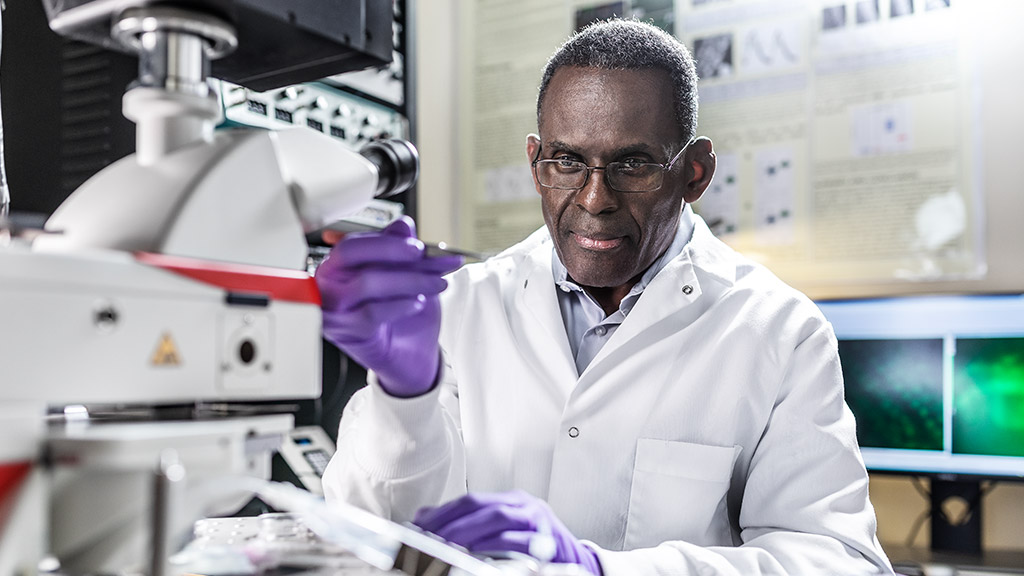Connections in Hearing, Pathways to Healing

Dwayne Simmons, PhD, The Cornelia Marschall Smith Endowed Professor and Chair in Baylor University’s Department of Biology, has dedicated his internationally recognized research to studying how sensory cells in the ear and neurons in the brain respond to aging. These sensory cells and neurons are connected by wiring that degenerates over time, a common disconnect revealed in many senior adults as hearing loss. On a broader level, he’s pursuing breakthroughs in the auditory system that could impact areas far beyond hearing.
“The research we’re doing in my laboratory is forging new pathways,” Simmons says. “How are we built inside of our brains and our nervous system, and how does that effect what we can do?”
A universal condition
The numbers Dr. Simmons shares paint a picture of an ailment that impacts almost everyone. Presbycusis—age-related hearing loss—afflicts 1 in 3 adults over the age of 65. At least 10 million adults in the United States suffer from some form of hearing loss, and around the globe, a quarter of all individuals over the age of 45, and half of over the age of 70, experience significant hearing loss. Statistically, nearly everyone will either experience hearing loss or have a loved one who does. The numbers alone make the auditory system a crucial field for study, but the implications of breakthroughs in this area offer even more opportunity.
“What we learn in one part of our nervous system has implications and direct applications to other parts of the brain as well,” Simmons says. “For example, the protein we study that regulates calcium signals in the sensory cells of the inner ear is used by cells in the immune system. This is really exciting work.”
Inside the Simmons Lab, housed among 508,000 state-of-the-art square feet in the Baylor Sciences Building, Simmons and his students spend countless hours examining cells through the lens of a microscope and probing the connections for clues that could someday yield solutions. At the heart of it all is the wiring between ear and brain. The sensory cells in the ear and neurons in the brain change their functions over time, and the wiring that develops around the second trimester of pregnancy begins a degeneration process that ultimately can lead to age-related hearing loss. Both ends of the spectrum are of interest.
“We found that, during development, before hearing starts, the wiring between neurons and sensory cells undergo some significant changes and look very different than after hearing starts,” Simmons says. “We are wondering whether, during aging, if the inner ear attempts to revert back to that early developmental wiring pattern. It raises the question whether the ear is trying to stop hearing loss by restarting these early developmental patterns.”
Research that heals
Simmons came to Baylor in 2016 after many fruitful years at UCLA, bridged in between by a year at the University of Sheffield in the United Kingdom, where he conducted research on a Fulbright fellowship. At UCLA, he enjoyed significant funding from the National Institutes of Health and directed three well-funded undergraduate programs. For an educator who believes deeply in research and its applications inside the classroom and around the globe, it was a meaningful position. But Simmons, whose work has always been compelled by a higher calling, found others of like mind as he got to know Baylor.
“I came very quickly to see that Baylor was very serious about becoming a top research university, something very few Christian universities have been able to do,” Simmons says. “I was at a point in my life and career where I was looking for something where there might be a greater intersection between my faith and my work.”
At Baylor, Simmons has quickly done his part to advance Baylor towards preeminence as a Christian research university. As chair of the Department of Biology, he is afforded the unique opportunity to work with and attract top faculty with a variety of specialties, which provides the opportunity to bolster interdisciplinary programs that provide more holistic solutions. Simmons and his colleagues are currently enhancing programs in areas like neglected tropical diseases, cancer, sensory biology and the microbiome. Another example of his commitment to research at all levels is the creation of the Baylor Transdisciplinary Undergraduate Experience (B-TRUE), a summer research program for undergraduates in the sciences.
The thread that binds it all together—long hours in the lab studying the auditory system and the brain, the drive to create meaningful research programs, intentional mentorship with students and even the choice to leave a “research juggernaut” at UCLA and come build a new one at Baylor—is the call to understand creation and find solutions that heal.
“In the Department of Biology, the science we teach and the science we research is all about understanding our world. I think you might even say we have a Biblical mandate to understand God’s creation, to be stewards and caretakers,” Simmons says.
“In addition to understanding our world, the Department of Biology at Baylor believes it must do research that also tries to heal our world. We have an incredible reputation for training future physicians and health care workers. We want to be training the next generation of students and researchers who will be developing cures that heal the sick. It is vital that we bring along passionate researchers who will continue to pursue solutions through research.”
ADDITIONAL LINKS